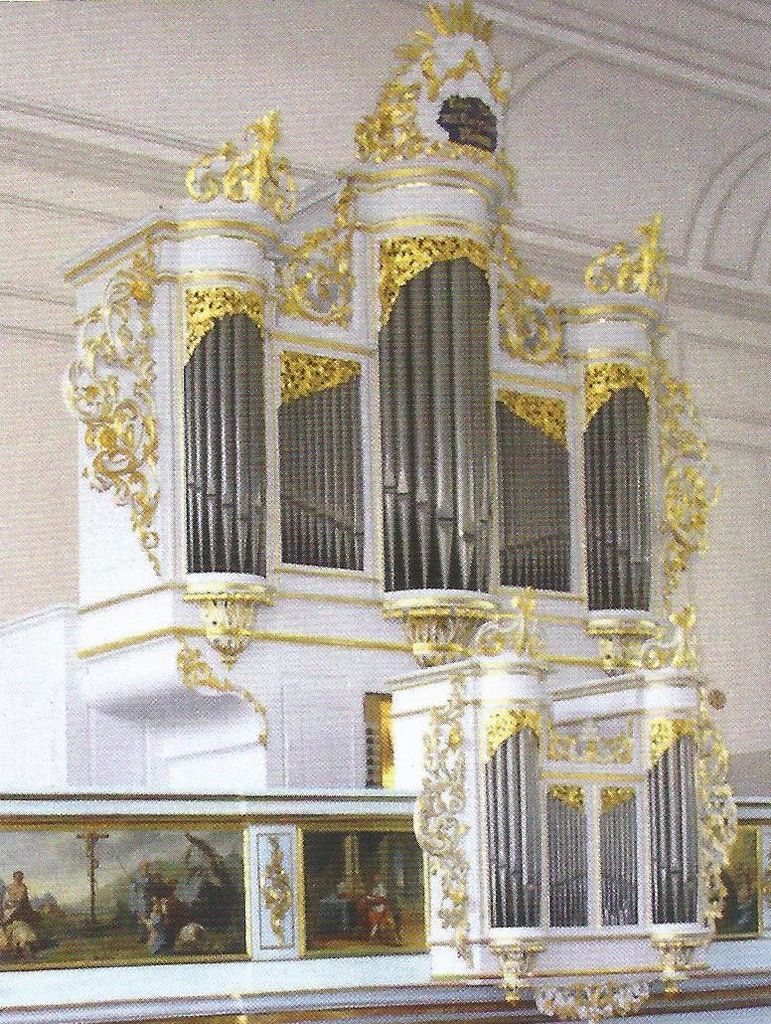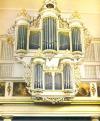Complete description of the selected organ

Strasbourg, France (Bas-Rhin (67)) - Église Sainte-Aurélie
Municipal: Strasbourg
Region:Alsace
Address: 16 Rue Martin Bucer, 67000, Strasbourg
Description nr.: 2000255.
Built by: Andreas Silbermann (1718)
Technical data
Specification
Grand Orgue (C-c'''): Bourdon 16' (from E) - 2015, Montre 8', Bourdon 8', Prestant 4', Flûte 4' - 2015, Quinte 2 2/3', Doublette 2', Tierce 1 3/5' - 2015, Cornet 5 rangs (8') (discant) - 1718/2015, Fourniture 3 rangs (1') - 2015, Cymbale 3 rangs (2/3') - 2015, Voix Humaine 8' - 2015.
Positif (C-c'''): Bourdon 8', Prestant 4' - 2015, Nazard 2 2/3' - 2015, Doublette 2' - 2015, Tierce 1 3/5' - 2015, Fourniture 3 rangs (1') - 2015.
Pédale (C-d'): Soubasse 16' - 2015, Octavbass 8' - 2015, Trompette 8' - 2015.
Couplers: Accouplement du Positif au Grand Orgue, Tirasse Grand Orgue - permanent.
Accessories: Tremblant Doux.
Other sources

Strasbourg, France (Bas-Rhin (67)) - Église Sainte-Aurélie
Municipal: Strasbourg
Region:Alsace
Address: 16 Rue Martin Bucer, 67000, Strasbourg
Description nr.: 2000255.
Built by: Andreas Silbermann (1718)
| Year | Builder | Opus | Activity | 1718 | Andreas Silbermann | new organ | 1765 | Johann Andreas Silbermann | restoration and enlargement | 1870 | Martin Wetzel | modify stoplist | 1884 | Wilhelm Koulen | modify stoplist | 1911 | Manufacture Dalstein-Haerpfer | rebuild | 1952 | Mühleisen Orgelbau | 4 | rebuild | 2015 | Quentin Blumenroeder | reconstruction |
- The organ in the Église Sainte-Aurélie in Strasbourg was built in 1718 by Andreas Silbermann for the previous church building. It had two manuals and pedal. The current baroque church building was dedicated in 1765. Johann Andreas Silbermann transferred the organ and installed the three prepared stops, making the total number of stops at the time twenty. In 1790, the organ was repainted in colors that better suited the interior of the church. The stop list was modified by Martin Wetzel in 1865 and 1870, and by Wilhelm Koulen in 1884.
- In 1911, the organ was rebuilt by Dalstein-Haerpfer. The Positif was re-installed as Récit Expressif, the action was made pneumatic and the number of stops was increased to 33. The resulting instrument was one of Albert Schweitzer's favorite organs, where he recorded works by Bach and Franck's three chorales. In 1952 Ernest Muhleisen rebuilt and enlarged the organ again. It now had three manuals and pedal, with in total 52 stops. On the sides of the main organ case Muhleisen placed two new cases with the pipework of the pedal. There were still seven stops of Silbermann preserved in this large instrument.
- The original concept of Silbermann was reconstructed in 2012-2015 to the situation of 1768 by Quentin Blumenroeder. The organ case has also been restored to its original condition.
Technical data
| Number of stops per division | |
| - Grand Orgue | 12 |
| - Positif | 6 |
| - Pédale | 3 |
| Total number of stops | 21 |
| Key action | Mechanical |
| Stop action | Mechanical |
| Windchest(s) | Slider chests |
| Pitch | a' = 460 Hz |
| Wind pressure | 72 mm |
Specification
Grand Orgue (C-c'''): Bourdon 16' (from E) - 2015, Montre 8', Bourdon 8', Prestant 4', Flûte 4' - 2015, Quinte 2 2/3', Doublette 2', Tierce 1 3/5' - 2015, Cornet 5 rangs (8') (discant) - 1718/2015, Fourniture 3 rangs (1') - 2015, Cymbale 3 rangs (2/3') - 2015, Voix Humaine 8' - 2015.
Positif (C-c'''): Bourdon 8', Prestant 4' - 2015, Nazard 2 2/3' - 2015, Doublette 2' - 2015, Tierce 1 3/5' - 2015, Fourniture 3 rangs (1') - 2015.
Pédale (C-d'): Soubasse 16' - 2015, Octavbass 8' - 2015, Trompette 8' - 2015.
Couplers: Accouplement du Positif au Grand Orgue, Tirasse Grand Orgue - permanent.
Accessories: Tremblant Doux.
| Other specifications | |
|---|---|
| Different specifications |
|
| Literature |
|
| Recordings |
|
| Links |
https://www.itineraires-silbermann.org/strasbourg-sainte-aurelie/ |
- Jörg R. Becker
- Bert Wisgerhof
 |
 |
 |
